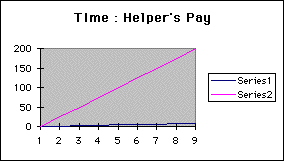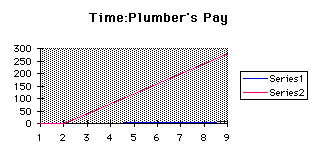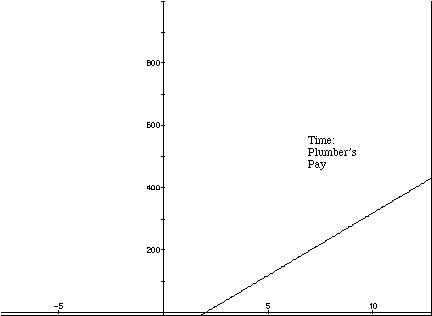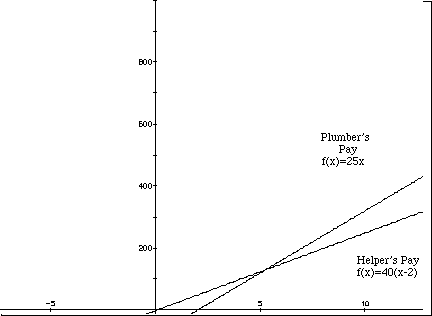
Activity 1 - Quadratic Functions:
Plumbers and Helpers
Objectives:
1. To explore functions in Algebra.
2. To make the transition from a typical algebra word problem to an
activity rich in the investigation and exploration of variables.
3. Investigate the relationships between variables that determine a
function
4. To investigate the ideas of variables and constants in a function
and to make distinctions between the two
5. To explore data and to find an algebraic expression for a given
situation
6. To be able to take several different mathematical approaches to
achieve "suitable" answers
Problem:
Investigate the amount of money earned by a plumber and his helper. The plumber earns $40 per hour and his helper earns $25 per hour. On a particular day, the helper begins work at
8:00 a.m., and the plumber begins work at 10:00 a.m. .
Discussion for Students:
Given the length of time that a person works and his rate of pay per unit of time, how does one find the worker's total earnings for the time period that he works?
Earnings = (Rate of pay) * (Length of time worked)
Questions:
1. At 9 a.m., how much money has the helper earned?
At 9 a.m., how much money has the plumber earned?
2. At 10 a.m., how much money has the helper earned?
At 10 a.m., how much money has the plumber earned?
3. At 11 a.m., how much money has the helper earned?
At 11 a.m., how much money has the plumber earned?
Application with Spreadsheet:
If the plumber and his helper "call it a day" at 4 p.m., use the
spreadsheet to show the number of hours that each person worked and his respective earnings.
Time Helper's hours Helper's earnings Plumber's hours Plumber's earnings
8:00 0 0 0 0
9:00 1 25 0 0
10:00 2 50 1 40
11:00 3 75 2 80
12:00 4 100 3 120
1:00 5 125 4 160
2:00 6 150 5 200
3:00 7 175 6 240
4:00 8 200 7 280
Variables and Constants:
1. A quantity that varies in a situation is called a variable. Can you name the variable in this scenario?
2. A quantity that stays the same in a given situation is called a constant. What are the constants in this scenario?
Expressing the Function Algebraically:
Write in step-by-step order, your method for obtaining your answers to the following questions.
1 a. If the helper works 7 hours, how much money will he have earned?
b. Given what you know about the variable in this situation, find a formula that expresses the helper's earnings. You should be able to use this formula no matter how long the helper works.
c. What is the relationship between the time that the helper works and the time that the plumber works?
2 a. If you are only told that the helper works 6 hours, demonstrate how you determine the number of hours that the plumber works.
b. Given what you know about the variable, x, which represents the helper's time, and the relationship that exists between the helper and the plumber's time, find a formula for that expresses the plumber's earnings.
Representing the Function Graphically:
Going back to the spreadsheet, plot the graphs of
1. Time (x), Helper's Pay (y)
2. Time (x), Plumber's Pay (y)

Graph 1
 Graph 2
Graph 2
Using the graphs, answer the following equations:
1. a. Who has made more money when the helper has worked
4 hours?
b. Who has made more money when the helper has worked 8 hours?
2. Confirm your answers by consulting the calculations that you obtained from the spreadsheet.
3. Can you predict when the plum ber's earnings and the helper's earnings will be equal? Use the following methods to do this:
a. Use the graph.
b. Use the spreadsheet.
c. Use Algebra.
Confirm Your Results:
Using Algebra X-Presser, graph the two formulas that YOU
came up with to calculate the helper's pay and the plumber's pay.


Now, graph the two functions together.

Compare this graph with the ones that you obtained from the spreadsheet. Did your equations produce the same graphs? If not, what do you think happened? Go back to your formulas and see if you can correct them so that your results are the same in spreadsheet and Algebra X-Presser.
Follow-Up :
In words, write what you have learned from this activity. One example might be to explain the relationship that exists between time and earnings, i.e., "As time increases / decreases the earnings . . . ".
Also, include any observations that you had and anything else that you have learned.
Activity 2- Quadratic Functions:
Pipe Cleaners and Area
Objectives:
1. To explore functions in Geometry
2. To investigate the relationship between area and height
3. To develop an intuitive feel for the behavior of related variable quantities
4. To understand maximum area, and upper and lower bounds
on the value of height
5. To make connections between the mathematical world and the real-world
6. To make connections between the geometric representation,(the graph), of the real-world phenomenon and the algebraic representation, (the function)
Initial Investigation:
I.
1. Using graph paper of 1x1 unit size, measure the length of the pipe cleaner.
2. Bend each end of the pipe cleaner upward so that each piece bent upward is one unit long. Each upward bent piece is called the height of the pipe cleaner.
3. The bottom part of the pipe cleaner is called the base . Using the graph paper, what is the length of the base when the height is 1 unit long?
Length of Base:______
4. The area (of the figure made from the pipe cleaner), is the number of squares above the pipe cleaner, but no higher then the tops fo the pieces that are bent upward. What is the area of the figure when the height is 1 unit long?
Area:_____________
II.
Now, straighten the pipe cleaner out. This time, turn th eend pieces upward so that the height of the figure is 2 units long.
a. Find the length of the base.
b. Find the area of the figure.
III.
Continue to straighten and bend the pipe cleaner upward one unit longer each time. When there is no longer enough pipwe cleaneer to continue, you may stop. Record your results below.
Height Base Area
1 18 18
2 16 32
3 14 42
4 12 48
5 10 50
6 8 48
7 6 42
8 4 32
9 2 18
1. What are the variables in this activity?
Even though there are several variables in this activity, it is necessary to focus our attention on only one at a time. For this reason, we will look at height.
2. Are there any constants in this activity?
3. Looking at the height, base, and area, do you see a relationship between the three measurements?
Application with Spreadsheet:
1. Using the relationship that you have found between the base, height, and area, make a spreadsheet from what you have found.
HEIGHT AREA BASE
1 18 18
2 32 16
3 42 14
4 48 12
5 50 10
6 48 8
7 42 6
8 32 4
9 18 2

2. a. The largest possible value of a variable is called its maximum. What is the maximum value for the area in this activity?
b. What is the value of the height when this maximum area is reached?
c. Does this value of the height also produce a maximum value for the base? Explain why or why not.
d. Using the spreadsheet, make a graph of the height and the area. Which one is the dependent variable? Which one is the independent variable? Explain the difference between the two concepts.
e. Describe what the graph looks like. What shape is the graph?
f. Describe where the maximum value for area is on the graph.
Bibliography
Froelich, Gary W.. Curriculum and Evlauation Standatrds for School
Mathematics: Connecting Mathematics. National Council of Teachers
of Mathematics, 1991; Reston,VA.